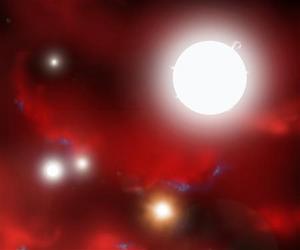
|
| ©REUTERS/Handout/David Aguilar
|
| In this artist's impression, swirling clouds of hydrogen and helium gases are illuminated by the first starlight to shine in the universe after the Big Bang. Japanese and U.S. scientists, writing in the journal Science, present the results of a sophisticated computer simulation of how the first stars in the universe came into being.
|
The first object to brighten the dark, primordial universe after the Big Bang was the tiny seed of a star that rapidly grew into a behemoth 100 times more massive than the sun, scientists said on Thursday.
This first generation of stars apparently lived hard and died quickly. While our sun may live 5 billion years, this first generation of stars likely lasted only a slim fraction of that -- about 1 million years, the researchers said.
Scientists think the universe was born in a Big Bang explosion 13.7 billion years ago and has been expanding ever since. But they have struggled to understand how the first stars formed in the aftermath of this cataclysm.
Japanese and U.S. astronomers ran a sophisticated computer simulation that showed how some of the hydrogen and helium gases strewn throughout the young universe came together to form the first generation of stars.
"These stars are thought to be the first sources of light and also the first sources of heavy elements such as carbon, oxygen and iron," Naoki Yoshida of Nagoya University in Japan, who worked on the study published in the journal
Science, said in a telephone briefing.
"If we want to understand how things came about and look the way they do now, we have to go back in time and understand how stars looked when they first began to form," added Lars Hernquist of Harvard University in Massachusetts.
COMPACT UNIVERSEAt the time, the universe was about 20 times as compact as it is now, Hernquist said. "We think that early in the universe, the only elements that existed were hydrogen and helium, with trace amounts of lithium," Hernquist added.
This matter was generally very smoothly distributed throughout the universe, but some regions had greater concentrations of it than others, the researchers said.
The effects of the gravity from this matter drew in more and more material over time, setting in motion clouds of hydrogen and helium that came together as a "protostar" -- the seed of a much larger star.
The first protostar was born about 300 million years after the Big Bang, the researchers said. Nuclear reactions inside the protostar made it the first object to cast starlight in what some astronomers call the "cosmic dark ages," they added.
It was a relatively tiny object at first, 1 percent the mass of the sun. But within about 10,000 years -- "the blink of an eye," according to the researchers -- it grew into a giant full-fledged star at least 100 times the sun's mass.
While none of the stars survive today, their influence remains.
The processes churning inside the stars synthesized the universe's first heavy elements. In dying, these stars may have blasted this stuff back into space to become building blocks of future stars and planets composed of many more elements.
Hernquist said these stars may have died in a very bright supernova or might have collapsed in on themselves, forming black holes with relatively little of their material ejected into space as ingredients for future stars.

Reader Comments
to our Newsletter